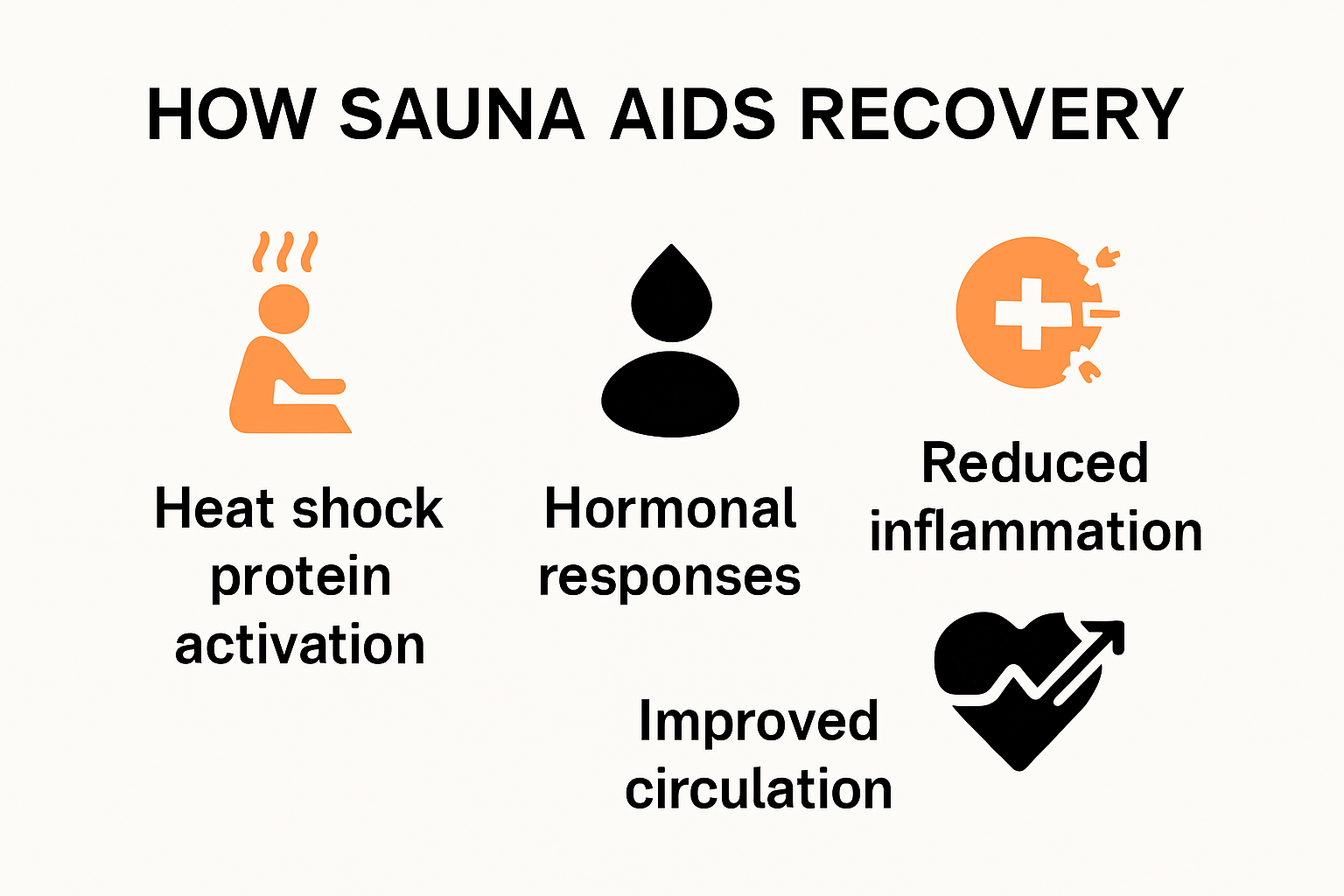
How Sauna Aids Recovery: Top Ways to Boost Wellness in 2025

Sauna therapy has taken the wellness world by storm, and for good reason. Studies show a 32 percent increase in endurance for athletes who add sauna sessions to their routine. Most people think it is just about feeling relaxed and sweating out toxins. Surprisingly, the real advantage lies in how sauna use can speed up muscle repair and cut down post-workout soreness. Discover why heat is becoming the recovery tool everyone is talking about.
Table of Contents
- Science Behind Sauna And Recovery
- Types Of Saunas And Their Recovery Benefits
- Best Practices For Using Sauna After Exercise
- Choosing Sauna Products For Home Wellness
Quick Summary
| Takeaway | Explanation |
|---|---|
| Sauna sessions enhance muscle recovery | Utilizing saunas, particularly at appropriate temperatures, significantly reduces muscle soreness and accelerates strength recovery after intense exercise. Research shows a controlled thermal stress environment activates recovery pathways such as increased cellular heat shock proteins. |
| Hydration is crucial for sauna effectiveness | Maintaining proper hydration before and during sauna sessions is essential to maximize recovery benefits, as the heat causes significant fluid loss through sweating. |
| Different sauna types target diverse recovery needs | Infrared, traditional Finnish, and steam saunas each offer unique benefits—ranging from deep tissue recovery to respiratory support—allowing individuals to choose based on their specific recovery goals. |
| Strategically plan sauna use for optimal benefits | Start with shorter sessions immediately after exercise and gradually increase duration, while monitoring your body’s response to avoid overexertion, thereby enhancing recovery outcomes. |
| Safety considerations are paramount | Individuals with health conditions should consult professionals and look for saunas with safety features like automatic temperature regulation and emergency shut-off mechanisms to ensure a safe experience. |
Science Behind Sauna and Recovery
The human body’s recovery process is a complex biological mechanism that can be significantly enhanced through strategic interventions like sauna use. Scientific research reveals compelling evidence about how sauna aids recovery by triggering profound physiological responses that support muscle repair, reduce inflammation, and optimize overall wellness.

Thermal Stress and Muscle Recovery Mechanisms
When exposed to intense heat, the body initiates a remarkable series of adaptive responses that directly impact recovery. Research published in the Journal of Science and Medicine in Sport demonstrated that traditional sauna bathing at 185°F for 15 minutes, performed three times weekly for six weeks, substantially reduced delayed onset muscle soreness (DOMS) and accelerated muscle strength recovery in athletes.
The heat exposure creates a controlled stress environment that stimulates multiple recovery pathways. Cellular Heat Shock Proteins activate, which play a crucial role in protecting muscles from damage and promoting protein repair. This mechanism helps athletes and fitness enthusiasts recover more efficiently after intense physical exertion.
Hormonal and Physiological Responses
Research in Frontiers in Physiology highlighted another critical aspect of sauna recovery: hormonal response. Heat exposure significantly increases growth hormone release, a key factor in muscle tissue repair and regeneration. Growth hormone stimulates protein synthesis, supports muscle development, and accelerates healing processes.
Additionally, sauna sessions trigger profound cardiovascular adaptations. The heat causes blood vessels to dilate, improving circulation and enhancing nutrient delivery to muscle tissues. This improved blood flow helps remove metabolic waste products accumulated during exercise and supports faster recovery.
Inflammation Reduction and Recovery Optimization
A study published in Biology of Sport revealed that a 30-minute post-exercise infrared sauna session could dramatically reduce muscle soreness and improve explosive strength recovery within 24 hours. The thermal stress induces an anti-inflammatory response, helping the body manage exercise-induced muscle microtrauma more effectively.
The body’s natural healing mechanisms are amplified during sauna sessions. Increased core temperature stimulates immune system responses, promotes cellular repair, and helps reset physiological stress markers. These processes are essential for athletes and fitness enthusiasts seeking optimal recovery and performance enhancement.
By understanding the science behind sauna recovery, individuals can strategically incorporate heat therapy into their wellness routines, leveraging biological mechanisms to support faster, more comprehensive physical restoration.
Types of Saunas and Their Recovery Benefits
Recovery strategies continue to evolve, and understanding the various sauna types can significantly impact an individual’s wellness journey. Each sauna style offers unique physiological benefits, creating targeted approaches to muscle recovery, stress reduction, and overall health optimization.
Below is a comparison table to help you quickly identify the primary features and recovery benefits of each sauna type mentioned in the article.
| Sauna Type | Temperature Range | Key Recovery Benefits | Unique Features |
|---|---|---|---|
| Infrared Sauna | 40-60°C (104-140°F) | Deep muscle penetration, reduced tension | Electromagnetic wave heat, lower ambient temp |
| Traditional Finnish Sauna | 80-90°C (176-194°F) | Cardiovascular adaptation, soreness reduction | Intense dry heat, low humidity |
| Steam Sauna | ~45-50°C (113-122°F)* | Respiratory support, muscle relaxation | High humidity, moist heat |
*Estimated temperature range based on standard steam sauna settings.
Infrared Saunas: Deep Tissue Recovery Technology
Research published in the Journal of Human Kinetics indicates that infrared saunas operate at lower temperatures (40–60°C) while providing deeper heat penetration into muscle tissue. This unique characteristic makes them particularly effective for athletes and fitness enthusiasts seeking targeted recovery mechanisms.
Infrared saunas use electromagnetic waves that directly warm body tissues, creating a more efficient heat transfer compared to traditional sauna methods. Muscle Penetration is a key advantage, allowing heat to reach deeper muscle layers and supporting faster recovery from strength and endurance training sessions. The gentle yet profound heat helps reduce muscle tension, improve circulation, and accelerate metabolic waste removal.
Traditional Finnish Saunas: Classic Recovery Approach
A comprehensive study in the Scandinavian Journal of Medicine and Science in Sports highlighted the remarkable recovery benefits of traditional Finnish saunas. Typically heated to 80–90°C with low humidity, these saunas have been associated with improved cardiovascular health and significant reduction in muscle soreness.
Traditional Finnish saunas create an intense thermal environment that triggers robust physiological responses. The high heat stimulates cardiovascular adaptation, enhances blood circulation, and promotes rapid muscle recovery. Athletes and active individuals can leverage these saunas to support comprehensive post-exercise restoration and reduce inflammation markers.
Steam Saunas: Respiratory and Recovery Support
Research from the American Journal of Respiratory Medicine suggests steam saunas provide unique recovery benefits beyond muscle restoration. By utilizing high humidity and moist heat, these saunas offer respiratory advantages that complement physical recovery processes.
Steam saunas create an environment that promotes deep breathing and can alleviate mild respiratory conditions such as congestion and bronchitis. The moist heat helps open airways, supports mucus clearance, and enhances overall respiratory function. This makes steam saunas an excellent option for individuals seeking holistic recovery that extends beyond muscular restoration.
Understanding these different sauna types enables individuals to select the most appropriate recovery method based on their specific wellness goals, physical condition, and personal preferences. Each sauna style offers a nuanced approach to supporting the body’s natural healing and restoration processes.

Best Practices for Using Sauna After Exercise
Optimizing recovery through sauna use requires strategic planning and understanding of physiological responses. Implementing a thoughtful approach can transform post-exercise sauna sessions from a simple wellness activity to a powerful recovery enhancement method.
For your convenience, the following table summarizes recommended best practices for sauna use after exercise, as described in the article.
| Best Practice | Recommendation |
|---|---|
| Timing | Start sessions immediately after exercise |
| Session Duration | Begin with 5-10 min, then gradually increase to 15-20 min |
| Hydration (Pre-Sauna) | Drink 16-20 oz water before entering sauna |
| Hydration (During Sauna) | Replenish with electrolyte-rich fluids |
| Temperature Range | Use moderate heat: 70-100°C (158-212°F) |
| Session Frequency | Aim for consistency (as opposed to maximal intensity) |
| Monitoring | Listen to body, avoid overexertion, watch for fatigue or dizziness |
| Medical Precaution | Consult professionals if health conditions are present |
Timing and Duration Strategies
Research published in Sports Medicine emphasizes the critical importance of precise sauna timing after exercise. A landmark study on male distance runners revealed that three weeks of post-training sauna sessions led to a remarkable 32% increase in run time to exhaustion, highlighting the potential performance benefits.
Recovery Protocols recommend starting with shorter sessions of 5-10 minutes immediately following intense physical activity. As your body adapts, gradually increase duration to 15-20 minutes. The key is listening to your body and avoiding overexertion. Professional athletes and fitness enthusiasts should aim for consistency rather than intensity, allowing physiological adaptations to occur naturally.
Hydration and Physiological Preparation
University of South Australia research indicates that proper hydration is paramount for maximizing sauna recovery benefits. Before entering a sauna, consume approximately 16-20 ounces of water to prepare your body for thermal stress.
During sauna sessions, continue hydrating with electrolyte-rich fluids. The intense heat causes significant fluid loss through sweating, making replenishment crucial. Athletes should monitor their hydration status carefully, recognizing that proper fluid balance supports muscle recovery, prevents cramping, and maintains optimal physiological function.
Temperature and Intensity Management
Clinical research from the International Journal of Sports Physiology and Performance suggests that moderate heat exposure provides the most significant recovery benefits. Ideal sauna temperatures range between 70-100°C (158-212°F), with lower temperatures offering more sustainable and comfortable recovery experiences.
Begin with lower temperatures and shorter durations, progressively increasing as your body becomes accustomed to heat stress. Individuals with pre-existing health conditions should consult healthcare professionals before implementing sauna recovery protocols. Monitor your body’s response, watching for signs of excessive fatigue, dizziness, or discomfort.
By understanding and implementing these evidence-based practices, individuals can transform sauna sessions from a simple relaxation technique into a sophisticated recovery enhancement strategy. The key lies in personalized approach, consistent application, and mindful physiological awareness.
Choosing Sauna Products for Home Wellness
Transforming your home into a personal wellness sanctuary requires careful consideration when selecting the right sauna product. The market offers diverse options, each with unique features designed to support individual health and recovery goals.
Understanding Sauna Technology and Performance
Mayo Clinic Proceedings research demonstrates that regular sauna use is associated with significant health benefits, including reduced risks of high blood pressure, cardiovascular diseases, and neurocognitive disorders. Selection Criteria should extend beyond aesthetic preferences to focus on technological capabilities and health optimization potential.
Infrared and traditional saunas offer distinct advantages. Infrared models provide more targeted heat penetration, while traditional saunas create a more intense thermal environment. Consider factors like electromagnetic frequency, heat distribution technology, and materials used in construction. High-quality saunas should offer consistent temperature control, energy efficiency, and durable construction.
Safety and Health Considerations
Medical research published in the Journal of Human Hypertension highlights critical safety parameters for home sauna selection. Southern Illinois University research recommends aiming for four to seven 20-minute sessions per week, heated to approximately 80° to 100° Celsius.
Individuals with pre-existing health conditions must exercise caution. Clinical studies indicate that those with unstable angina, recent myocardial infarction, or severe aortic stenosis should consult healthcare professionals before sauna installation. Look for products with built-in safety features like automatic temperature regulation, emergency shut-off mechanisms, and low-EMF emission technologies.
Practical Installation and Maintenance Factors
Home sauna selection involves more than technical specifications. Consider spatial requirements, electrical infrastructure, and long-term maintenance needs. Measure available space carefully, ensuring proper ventilation and electrical compatibility. Portable infrared models offer flexibility for smaller living spaces, while built-in traditional saunas provide a more permanent wellness solution.
Evaluate warranty coverage, customer support, and replacement part availability. Reputable manufacturers should offer comprehensive documentation, installation guidance, and responsive technical support. Factor in energy consumption, potential installation costs, and ongoing maintenance expenses when making your selection.
Ultimately, choosing a home sauna is an investment in personal wellness. By understanding technological capabilities, prioritizing safety, and considering practical implementation factors, you can create a transformative recovery and relaxation environment tailored to your specific health objectives.
Frequently Asked Questions
How does sauna use enhance muscle recovery?
Sauna use enhances muscle recovery by stimulating cellular heat shock proteins that help protect muscles from damage and promote protein repair, leading to reduced soreness and accelerated recovery after intense exercise.
What are the different types of saunas and their benefits?
There are three main types of saunas: infrared saunas provide deep tissue heat for muscle recovery, traditional Finnish saunas improve cardiovascular health and muscle soreness, and steam saunas offer respiratory benefits and relaxation.
How long should I use the sauna after exercising?
It is recommended to start with sauna sessions of 5-10 minutes immediately after exercise, gradually increasing to 15-20 minutes as your body adapts to the heat.
What should I do to stay hydrated during sauna sessions?
Before entering the sauna, drink 16-20 ounces of water, and during the session, replenish fluids with electrolyte-rich beverages to compensate for the loss caused by sweating.
Transform Recovery With a Premium Sauna Experience
After learning how targeted sauna sessions can accelerate muscle repair, reduce soreness, and even boost endurance, you might be wondering how to bring these benefits into your daily wellness routine. If you are tired of feeling drained after every workout or frustrated by stubborn post-exercise muscle aches, the right sauna solution at home can change the way you recover. Best Life Sauna offers a curated selection of infrared, traditional, and outdoor sauna models designed to deliver deep tissue recovery, optimal heat therapy, and long-lasting relaxation. Each product is chosen to support everything you have read about: elevated heat shock protein activation, enhanced circulation, and faster, more complete muscle restoration.
 Ready to invest in your long-term health and finally experience the proven recovery advantages highlighted in this article? Join others who have already transformed their wellness journey with Best Life Sauna. Shop today to explore our full collection of premium saunas and wellness essentials. Benefit from our price match guarantee, free shipping on qualifying orders, and responsive customer support. Start now and discover how a high-quality sauna from Best Life Sauna can help you unlock the next level of post-workout recovery at home.
Ready to invest in your long-term health and finally experience the proven recovery advantages highlighted in this article? Join others who have already transformed their wellness journey with Best Life Sauna. Shop today to explore our full collection of premium saunas and wellness essentials. Benefit from our price match guarantee, free shipping on qualifying orders, and responsive customer support. Start now and discover how a high-quality sauna from Best Life Sauna can help you unlock the next level of post-workout recovery at home.

